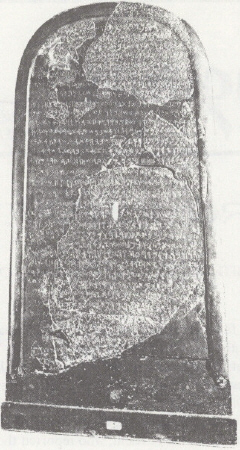From Israel The Moabite Stone - A Solution To A Conflict -- By: Anonymous
Journal: Bible and Spade (First Run)
Volume: BSP 01:2 (Spring 1972)
Article: From Israel The Moabite Stone - A Solution To A Conflict
Author: Anonymous
BSP 1:2 (Spring 1972) p. 55
From Israel
The Moabite Stone - A Solution To A Conflict
One of the most famous discoveries from Biblical archaeology is that of the Moabite Stone, also known as the Mesha Inscription. The inscribed stone slab, three feet ten inches high, two feet wide, and 10½ inches thick, came into the possession of an Arab sheikh at Dhiban in eastern Palestine. Dhiban is Biblical Dibon in what was once the territory of ancient Moab, east of the Dead Sea. In August, 1868, the Arab sheikh showed the stone to a German missionary named F. Klein, who reported the find to the authorities.
Both the Germans and the French were interested in the stone and quickly dispatched consular officials to buy it from the Arabs. An argument over the stone soon developed. The Arabs, sensing that they had an object of value, built a fire under the stone, poured water over it to break it into pieces and divided the fragments which they believed would bless their grain crops.
Fortunately, a French archaeologist had been able to obtain a squeeze, or impression, of the inscription before the stone was destroyed. Efforts were made to recover the fragments that had been scattered, and about two-thirds of the text was recovered. With the help of the squeeze, the stone was reconstructed and placed in the Louvre in Paris.
The inscription contains 39 lines of writing in Moabite, a language closely akin to Biblical Hebrew. In the inscription, Mesha, king of Moab, commorates his revolt against the Omride dynasty of Israel. It is of importance to
BSP 1:2 (Spring 1972) p. 56

The restored Moabite Stone
Biblical scholars for both linguistic and historical studies. It verifies Biblical records since it mentions kings and gods that are also mentioned in the Bible: Mesha, king of Moab; Omri, king of Israel; Chemosh, god of Moab, and Jehovah (Yahweh), God of the Israelites.
The revolt of King Mesha described in the inscription is also recorded in the Bible. Omri, king of Israel from about 885 to 874 B.C., defeated Moab and brought them under his control. He maintained control over Moab throughout his reign. Omri’s son Ahab succeeded him and also kept Moab under Israelite dominance. Following Ahab’s death, Moab revolted as recorded in 2 Kings 1:1 and 3:5.
There has been one point of apparent conflict between the record of Scripture and the Moabite Stone. 2 Kings 1:1 and 3:5 state that Mesha’s revolt took place after Ahab, Omri’s son, died. ...
Click here to subscribe
